Two Centuries of Climate Change and Climate Variability, East Coast Australia
Abstract
:1. Introduction
2. Methods
3. Findings
3.1. Sea Level and Climate Change
3.2. IPO and Sea Level
3.3. IPO and Climate Variability
3.3.1. Drought Periods
3.3.2. Storm Periods
- Exposure of heavy mineral lenses on beaches (mined by hand for gold).
- Serious problems with construction of breakwaters; at Trial Bay, New South Wales they were continually destroyed during construction and abandoned; at the Clarence River, New South Wales they were continually damaged due to breakwaters during construction.
- Permanent breach of the barrier dune and the permanent division of Stradbroke Island, southern Queensland.
- Storm erosion restricted the use of the beach for travel along the coast’s most eastern beaches (Seven Mile and Tallow beaches, northern New South Wales).
3.3.3. IPO Influence on Climate and Coastal Change
- Negative IPO phase—sea level is above long-term trend, with storm periods and major coastal erosion. For example, the 1860s to 1890s and from the early 1950s to mid-1970s.
- Positive IPO phase—sea level is below long-term trend with drought periods and beach accretion. For example, early 1900s, 1940s.
- Periods of transition between these phases—an example is from 1946 to 1952, when IPO was changing from positive to negative. During this transition, the sea level rose rapidly with increasing storminess and erosion.
3.3.4. Anomalous Periods
4. Discussion
Acknowledgments
Author Contributions
Conflicts of Interest
References
- Helman, P. Two Hundred Years of Coastline Change and Future Change, Fraser Island to Coffs Harbour, East Coast Australia. Ph.D. Thesis, Southern Cross University, Lismore, Australia, 2007. [Google Scholar]
- Hadley Centre MetOffice. Available online: http://www.cru.uea.ac.uk/cru/projects/soap/pw/data/model/hadcm3/hadcm3_sealevel.htm (accessed on 3 March 2017).
- Cazenave, A.; Nerem, R.S. Present-day sea level change: Observations and causes. Rev. Geophys. 2004, 42. [Google Scholar] [CrossRef]
- Power, S.; Casey, T.; Folland, A.; Colman, A.; Mehta, V. Inter-decadal modulation of the impact of ENSO on Australia. Clim. Dyn. 1999, 15, 319–324. [Google Scholar] [CrossRef]
- Salinger, M.J.; Renwick, J.A.; Mullan, A.B. Interdecadal Pacific Oscillation and South Pacific climate. Int. J. Climatol. 2001, 21, 1705–1721. [Google Scholar] [CrossRef]
- Verdon, D.C.; Franks, S.W. Long term behaviour of ENSO—Interactions with PDO over the last 400 years inferred from paleoclimate records. Geophys. Res. Lett. 2006, 33. [Google Scholar] [CrossRef]
- Verdon, D.C. Pacific and Indian Ocean Climate Variability-Implications for Water Resource Management in Eastern Australia. Ph.D. Thesis, University of Newcastle, Callaghan, Australia, 2007. [Google Scholar]
- Francis, R.C.; Hare, S.R. Decadal scale regime shifts in the large marine ecosystems of the north-east Pacific: A case of historical science. Fish. Oceanogr. 1994, 3, 279–291. [Google Scholar] [CrossRef]
- Francis, R.C.; Hare, S.R.; Mantua, N.J.; Wallace, J.M.; Zhang, Y. A Pacific Interdecadal climate oscillation with impacts on salmon production. Bull. Am. Meteorol. Soc. 1997, 78, 1069–1079. [Google Scholar]
- Goring, D.; Bell, R. Sea level on the move? Water Atmos. 2001, 9, 20–21. [Google Scholar]
- Barnard, P.L.; Short, A.D.; Harley, M.D.; Splinter, K.D.; Vitousek, S.; Turner, I.L.; Allen, J.; Banno, M.; Bryan, K.R.; Doria, A.; et al. Coastal vulnerability across the Pacific dominated by El Nino/Southern Oscillation. Nat. Geosci. 2015, 8, 801–807. [Google Scholar] [CrossRef]
- Helman, P.; Tomlinson, R.B. Coastal Storms and Climate Change Over the Last Two Centuries, East Coast Australia. In Solutions to Coastal Disasters 2008; Wallendorf, L., Ewing, L., Jone, C., Jaffe, B., Eds.; ASCE: Reston, VA, USA, 2008; pp. 139–146. [Google Scholar]
- Goodwin, I.D.; Stables, M.A.; Olley, J.M. Wave climate, sediment budget and shoreline alignment Eeolution of the Iluka—Woody Bay sand barrier, northern New South Wales, Australia since 3000 yr BP. Mar. Geol. 2006, 226, 127–144. [Google Scholar] [CrossRef]
- Sloss, C.R.; Jones, B.G.; Murray-Wallace, C.V.; McClennan, C.E. Holocene Sea Level Fluctuations and the Sedimentary Evolution of a Barrier Estuary: Lake Illawarra, New South Wales, Australia. J. Coast. Res. 2005, 21, 943–959. [Google Scholar] [CrossRef]
- Pugh, R.S. Briefing: Some observations on the influence of recent climate change on the subsidence of shallow foundations. Proc. Inst. Civ. Eng. Struct. Build. 2002, 155, 23–25. [Google Scholar] [CrossRef]
- Mckeon, G.M.; Hall, W.B.; Yee Yet, J.; Stone, G.S.; Crimp, S.J.; Peacock, A.; Richards, R.; Tynan, R.W.; Watson, I.W.; Power, S.B. Learning from history: Land and pasture degradation episodes in Australia’s rangelands. In Proceedings of the Conference on Managing Australian Climate Variability (CVAP), Albury, Australia, 23–25 October 2000; Power, S.B., Della Marta, P., Eds.; Bureau of Meteorology: Melbourne, Australia, 2000; pp. 64–67. [Google Scholar]
- Callaghan, J.; Helman, P. Severe Storms on the East Coast of Australia 1770–2008, Griffith Centre for Coastal Management; Griffith University: Gold Coast, Australia, 2008. [Google Scholar]
- Nicholls, N. Climate outlooks: From revolutionary science to orthodoxy. In A Change in the Weather: Climate and Culture in Australia, 2005; Sherratt, T., Griffiths, T., Robin, L., Eds.; National Museum of Australia Press: Canberra, Australia, 2005; pp. 18–29. [Google Scholar]
- Smith, A.W.; Jackson, L.A. Assessment of the past extent of cyclone beach erosion. J. Coast. Res. 1990, 6, 73–86. [Google Scholar]
- Chapman, D.M.; Geary, M.; Roy, P.S.; Thom, B.G. Coastal Evolution and Coastal Erosion in New South Wales; Coastal Council of New South Wales: Sydney, Australia, 1982.
- Zoulas, J.G.; Orme, A.R. Multidecadal-scale beach changes in the Zuma littoral cell, California. Phys. Oceanogr. 2007, 28, 277–300. [Google Scholar] [CrossRef]
- Brenstrum, E. The cyclone of 1936: The most destructive storm of the Twentieth Century? Weather Clim. 2000, 20, 23–27. [Google Scholar]
- Horton, B.P.; Rahmstorf, S.; Engelhart, S.E.; Kemp, A.C. Expert assessment of sea-level rise by AD 2100 and AD 2300. Quat. Sci. Rev. 2014, 84, 1–6. [Google Scholar] [CrossRef]
| 1 | IPO (plotted inverse) 1856 to 1870 after Reference [4]. 1871–2013 version HADISST IPO JFM1871-AMJ2004, low pass 11-year Chebyshev filtered from Hadley Centre, Meteorology Office, UK. Dataset supplied by Scott Power, Research Centre, Bureau of Meteorology, Melbourne. |
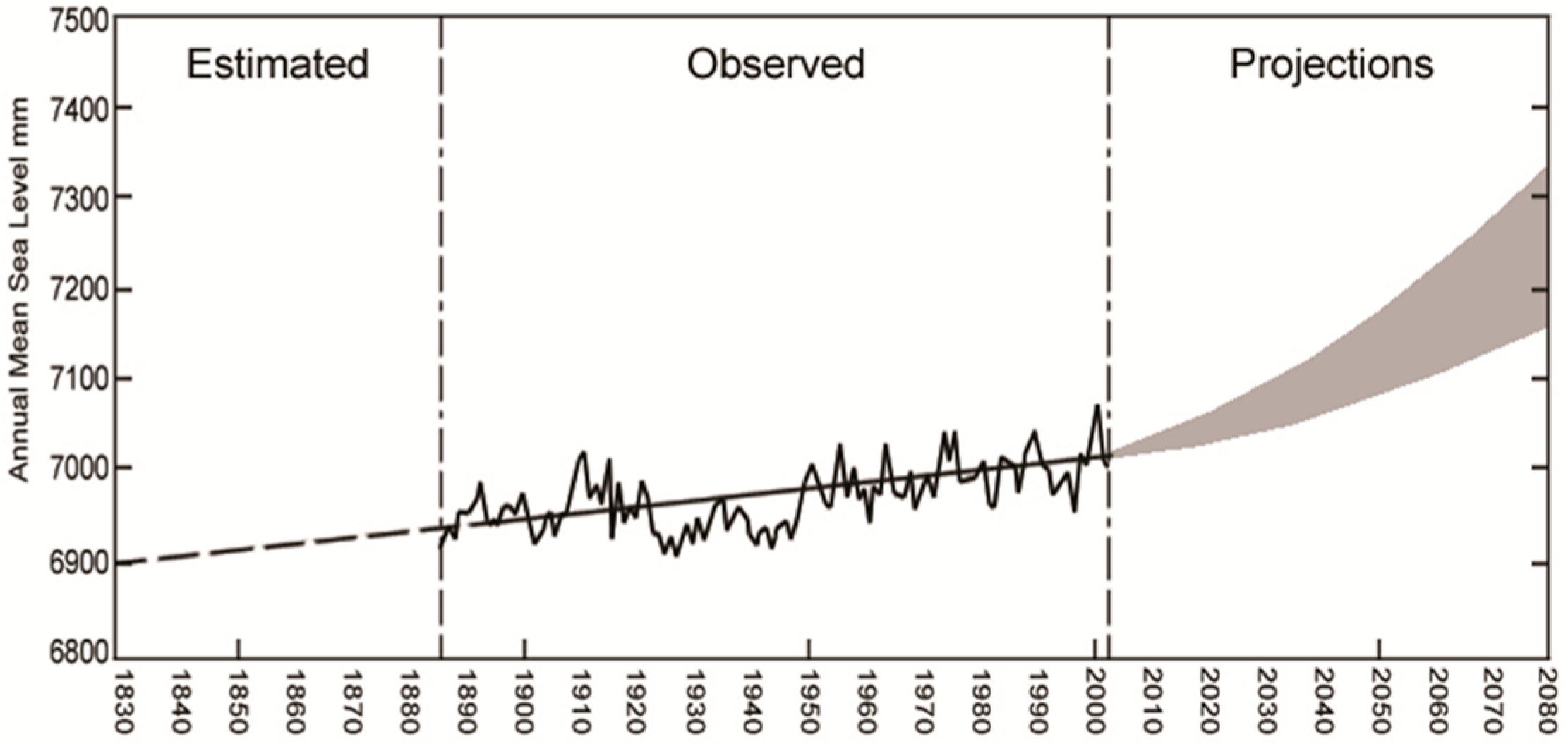
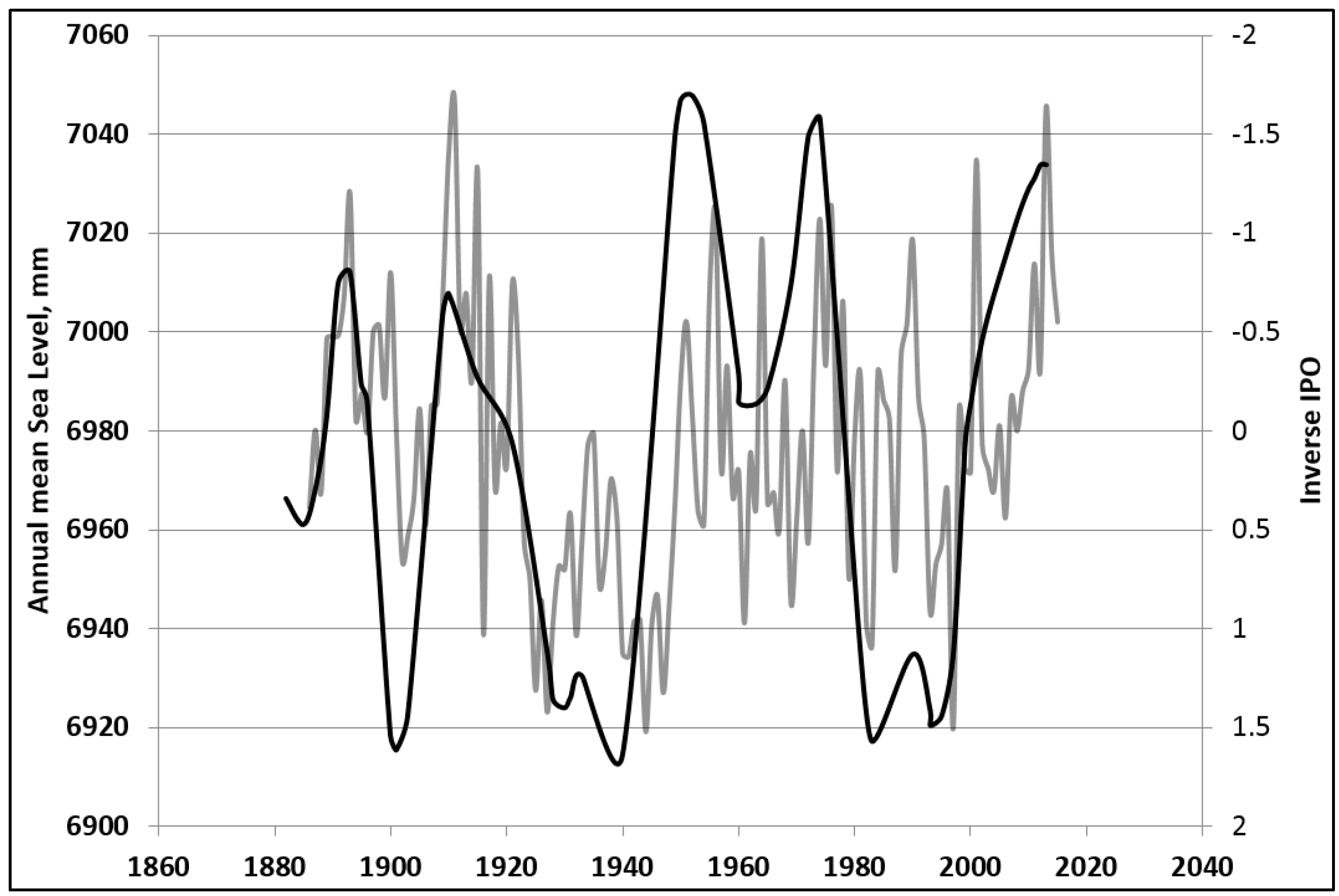
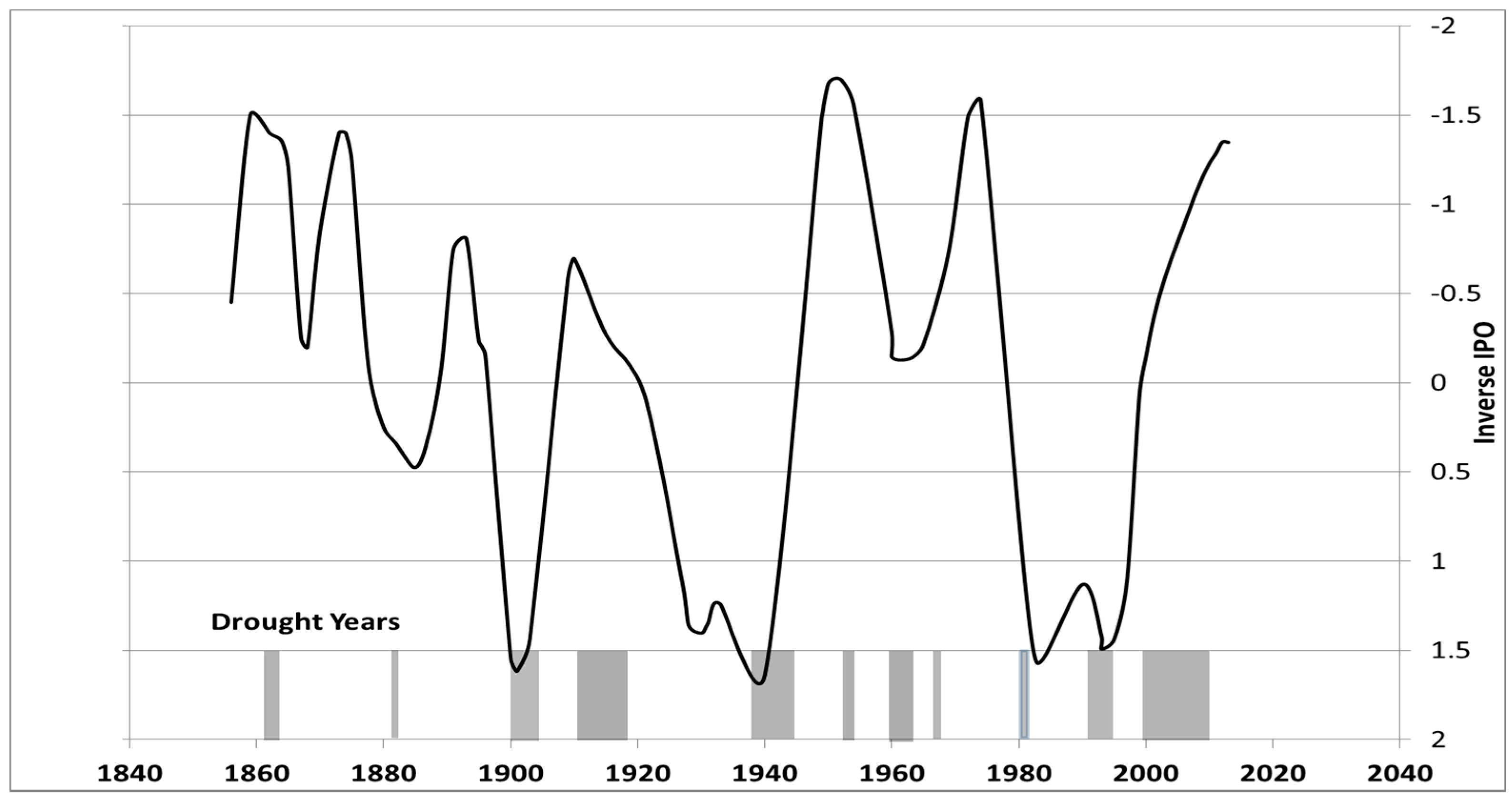
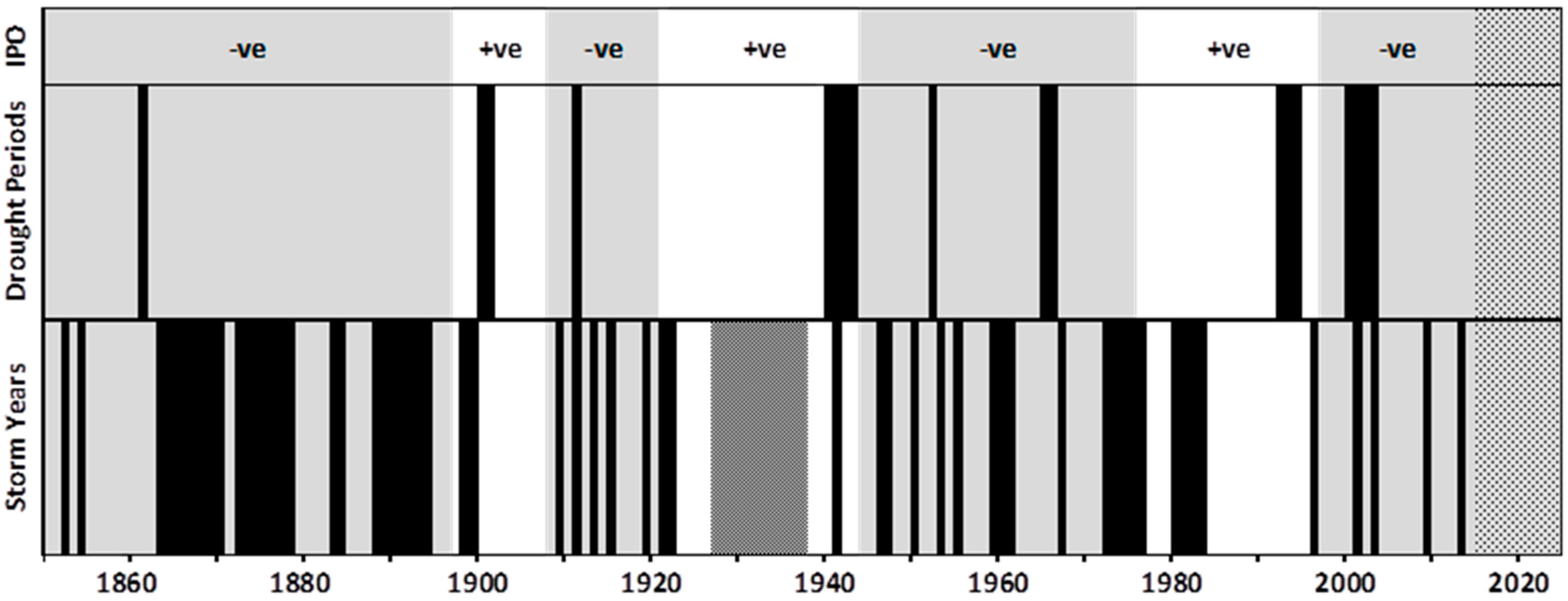
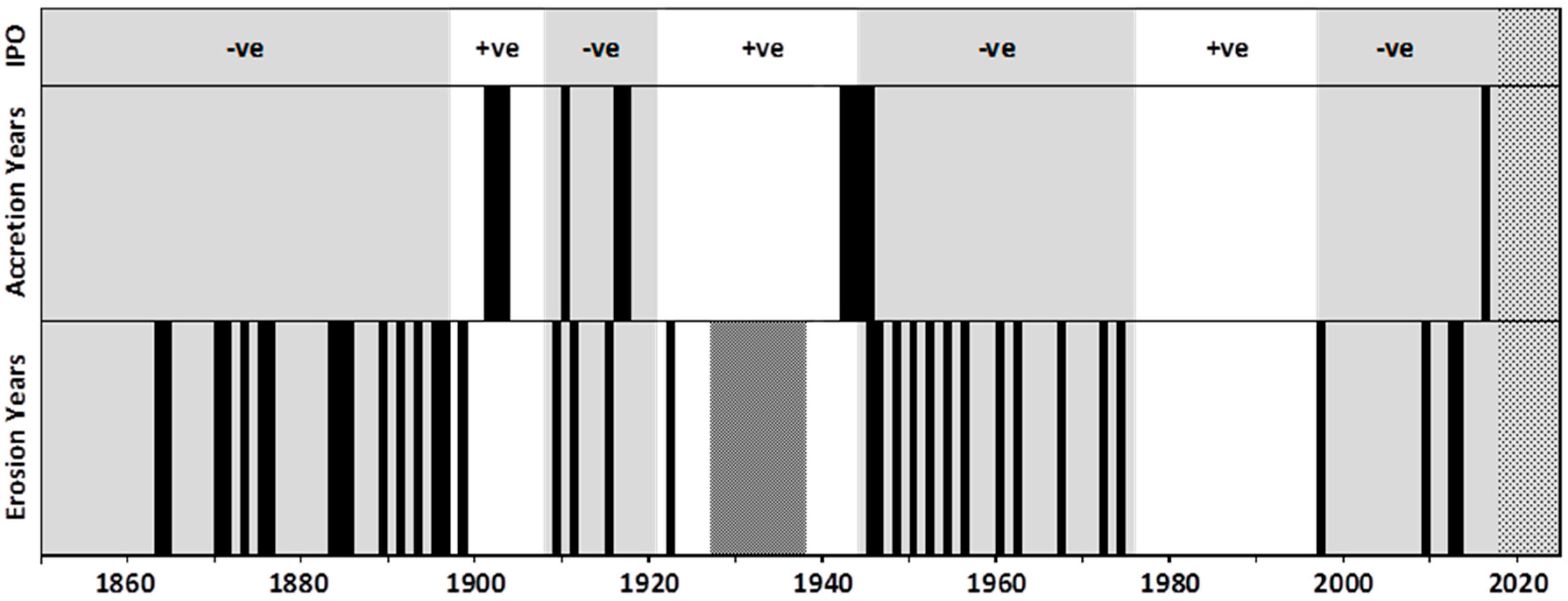
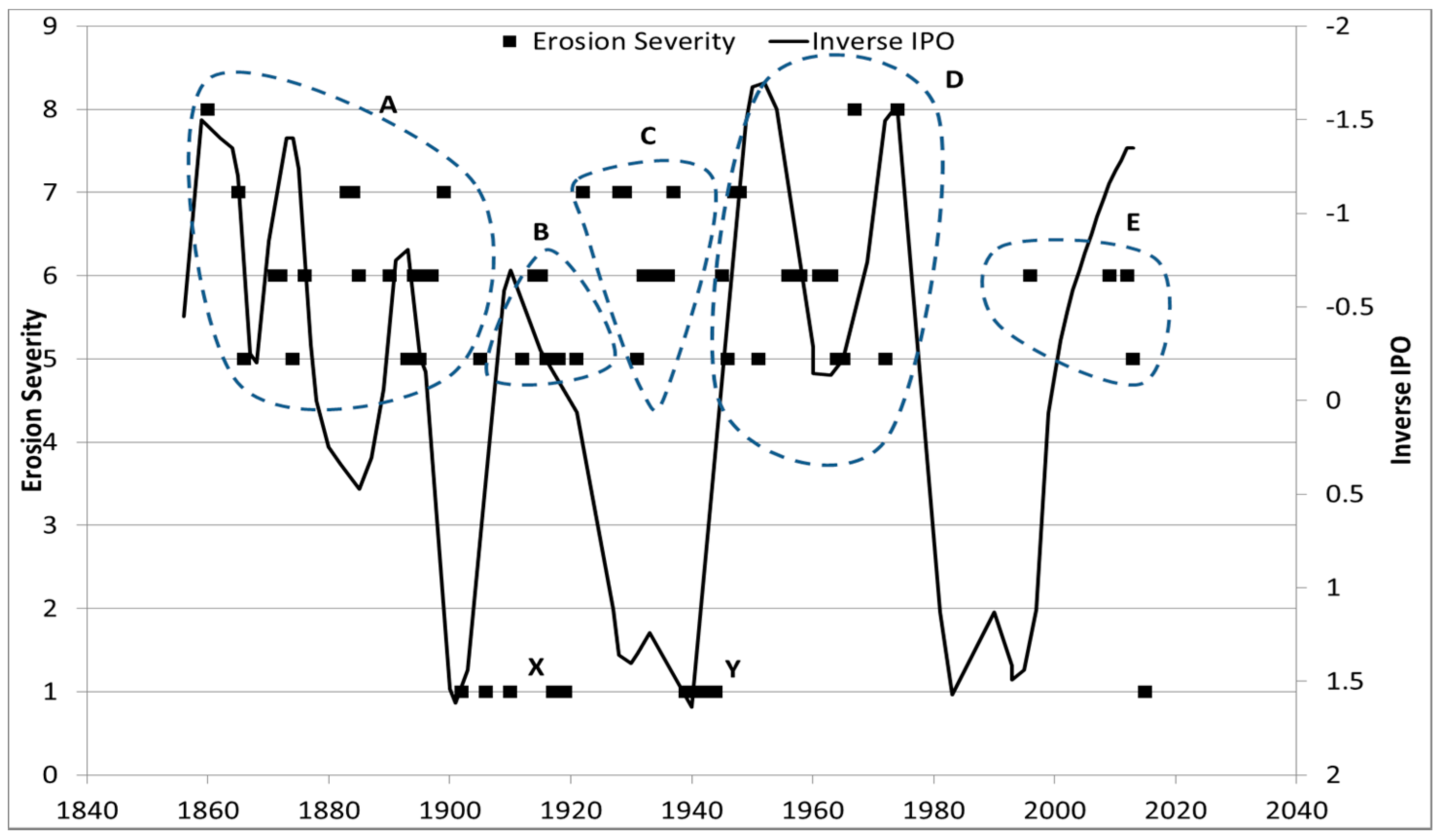
© 2018 by the authors. Licensee MDPI, Basel, Switzerland. This article is an open access article distributed under the terms and conditions of the Creative Commons Attribution (CC BY) license (http://creativecommons.org/licenses/by/4.0/).
Share and Cite
Helman, P.; Tomlinson, R. Two Centuries of Climate Change and Climate Variability, East Coast Australia. J. Mar. Sci. Eng. 2018, 6, 3. https://doi.org/10.3390/jmse6010003
Helman P, Tomlinson R. Two Centuries of Climate Change and Climate Variability, East Coast Australia. Journal of Marine Science and Engineering. 2018; 6(1):3. https://doi.org/10.3390/jmse6010003
Chicago/Turabian StyleHelman, Peter, and Rodger Tomlinson. 2018. "Two Centuries of Climate Change and Climate Variability, East Coast Australia" Journal of Marine Science and Engineering 6, no. 1: 3. https://doi.org/10.3390/jmse6010003




